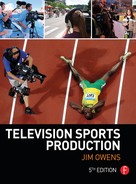Chapter 16
Production Safety
Safety during production refers to avoiding any unnecessary risks or danger. Implementing safety procedures and establishing a safe work environment for your crew is one of the fundamental aspects of the production plan.
Helen Borobokas-Grinter, Producer
Health and safety must always be considered when working on a remote production. A healthy crew is essential for a successful remote production. Remotes may require more endurance than other productions because equipment has to be unloaded from the mobile unit and then placed on the field of play. Remote production crews may have to set up heavy cameras in freezing or sweltering temperatures or may have to carry equipment up high scaffolding. For example, at an Alpine event, the camera crew may need to ski into positions and then stand for hours in freezing weather. Most injuries at an event do not happen during the event; they occur from crew members either lifting too much weight or falling before or after the event. Every year, deaths occur in the television industry. Usually, simple precautions can be taken to avoid injury.
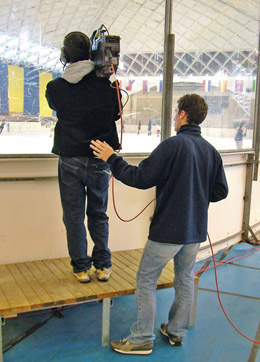
Figure 16.1
The camera assistant is responsible for looking out for the camera operator. This includes making sure that they do not get hit by an athlete or something like a ball. They must also ensure that the camera operator does not run into something or back off a step or platform.
The crew must be careful to take care of themselves. That means that they need to wear appropriate clothing for whatever weather occurs. Crew members are responsible for looking out for each other as well (see Figure 16.1). It is also important that they stay hydrated, which means that hot/cold drinks need to be available as needed. Production personnel need to keep in mind that exhausted people make more mistakes than usual, so should take regular breaks. Only personnel who have received the appropriate training should be using equipment such as dollys, jibs, Steadicams, and other equipment.
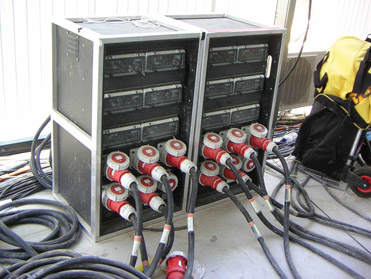
Figure 16.2
Remote trucks utilize a high level of electrical power. Only the truck engineers should touch any of the connection points.
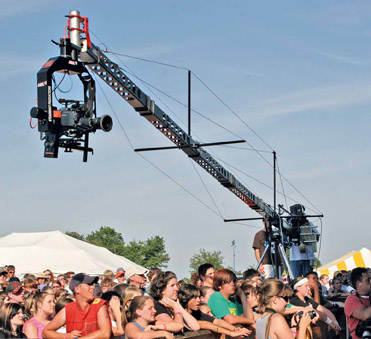
Figure 16.3
Be careful not to let high equipment such as jibs or ladders hit power lines.
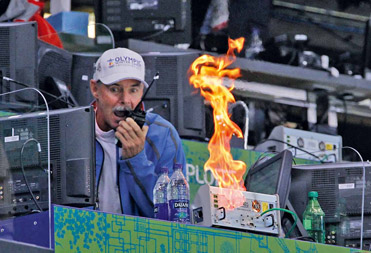
Figure 16.4
If there is an electrical fire, do not use water. Make sure that the appropriate fire extinguisher is nearby before the event.
When working at a remote production, keep in mind the following aspects of health and safety.
Trips and Slips
One of the main causes of the injuries that occur on a remote production are from people slipping or tripping:
- Cables must be kept from tripping athletes, participants, crew, audience.
- Use caution around icy wet surfaces.
- Keep equipment bags and cases out of normal pathways.
- Schedule plenty of time to get the job done. When crews have to hurry to meet deadlines, they may mistakes.
Weight
The other major cause of injuries, as mentioned earlier, is lifting too much weight. Do not lift too much weight; ask for help. Excessive loads can easily cause permanent damage.
Hearing
Some events, such as auto racing, may have very high levels of noise. Crew members should take precautions to protect their hearing by wearing earplugs or noise-cancelling headsets.
Electrical Power
Mobile units require a large amount of electrical power. The truck engineer is the only person who usually deals with that power, especially when hooking up the truck. Normally, no one else should be near the power area (see Figure 16.2).
Contact with overhead electric lines can be lethal. Working near overhead power lines must be only undertaken where there is a horizontal safe distance of 30 feet. The safe distance must take into account the reach of camera booms, cranes/jibs, ladders, and scaffolding (see Figure 16.3).
If a crane jib, scaffold pole, ladder, camera boom, or similar object makes contact with power lines, an electric current can flow that can cause a risk of fatal or severe shock or burns to any person in the immediate vicinity. This can also occur with objects made from material such as wood or plastic, which are normally regarded as electrical insulators. If damp or dirty, these substances are capable of transmitting sufficient current to cause dangerous or fatal electric shock (see Figure 16.4).
Winter Olympic Production
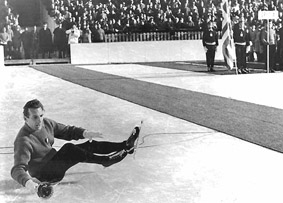
The Olympic Winter Games were broadcast live for the first time at the 1956 Cortina Games. The last torch carrier stumbled and fell over the television cable placed on the ice surface of the stadium. Although the torch was dropped, the flame was soon re-ignited.
IOC Marketing Fact File
Camera Platform Guidelines
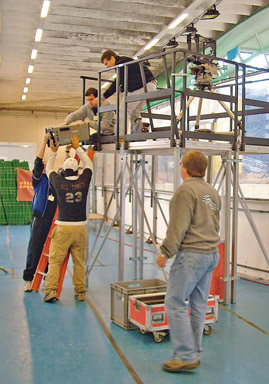
- Personnel should have both hands free when climbing an access ladder to a platform. One person may be on the ladder at a time.
- Avoid carrying too much at a time since overloads increase the risk of tripping or dropping articles.
- When using a hoist, do not exceed the working load of the equipment.
- Personnel must stay inside the guardrails of the platform. 5. No equipment should be extended outside the line of the guardrail unless it is properly anchored to a secure point on the platform to prevent it from falling.
Cables
Mobile unit cables need to be protected so that people, cars, or equipment do not rub or walk on them, wearing the insulation thin or breaking the wires. The cables also need to be secured in such a way that they do not pose a hazard for the crew or visitors. All cable connections need to be protected against the weather by wrapping them in plastic or placing them under cover. In some areas, local codes dictate how cabling is done (see Figures 16.5 and 16.6).
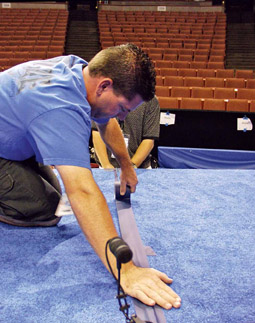
Figure 16.5
All cables should be taped down to protect people from tripping.

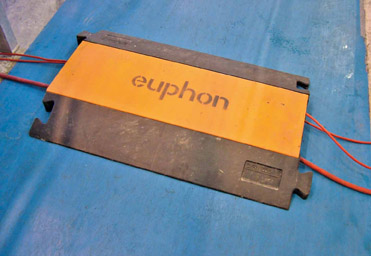
Figure 16.6
Cable trays can be used to give a high level of protection to cables. These trays can even protect the cables from cars driving over them.
Weather
Weather needs to be monitored at all times during outdoor productions. Bad weather can create a problem at any remote production. In remote situations, lightning can strike the truck, cameras, or crew members. Freezing weather creates ice, causing hazards for the crew and possibly adding weight to hanging cables. If rain gets into connections, the moisture could cause electrical shocks. High winds can create problems for the crew, especially if scaffolding is being used.
Heights
Remote productions invariably require crew members to be at high vantage points on the roof of a truck, on scaffolding, or climbing somewhere to run cables or hang lights.
Precautions need to be taken to ensure that crew members do not fall from these areas. Most injuries on remote sites result from falls. A safety harness should be used when a crew member is in a high area (see Figure 16.7).
It is not uncommon for a cameraperson to concentrate so much on their shot while following a subject that they do not realize they are about to step off the scaffolding.
High cranes and microwave transmission masts are other production areas that present height obstacles. When setting up this equipment, it is critical to avoid any power lines. Each year, people die from hitting power lines with television remote equipment.
Crew members need to be cautious when placing equipment or scaffolding on uneven ground. They can easily overturn, causing injury to the crew and damage to the equipment.
Hazardous Areas
Many areas of a remote production can be hazardous and require caution. For example, working as a camera operator next to a field of play can be a fairly dangerous place. Personnel placed in hazardous areas have to be especially aware of what is going on around them at all times and be prepared to move out of the way of the action when necessary.
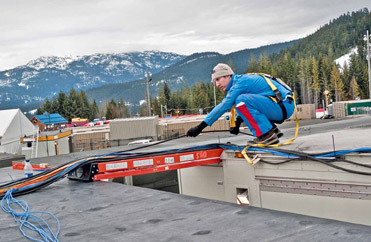
Figure 16.7
When working at heights, always use a safety harness.
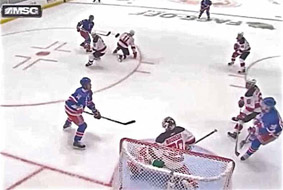
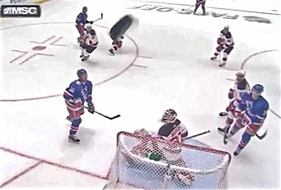
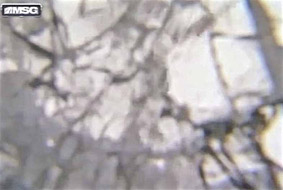
Figure 16.8
Caution must be used around the field of play. This sequence of photos happened within a couple of seconds. The first photo shows the player about to hit the hockey puck. Notice in the second photo the hockey puck in the air (upper middle of photo). The third photo shows the result of the puck hitting the camera. Think of the damage that could occur if a puck were to hit a person.
